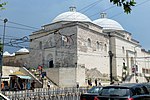Beyazıt massacre
1970s in Istanbul1970s murders in Turkey1978 crimes in Turkey1978 in Turkey1978 murders in Asia ... and 10 more
1978 murders in EuropeGrey Wolves (organization) attacksIstanbul UniversityMarch 1978 crimesMarch 1978 events in EuropeMass murder in 1978Mass murder in TurkeyMassacres in 1978Massacres in TurkeyPolitical violence in Turkey
The Beyazıt massacre (Turkish: Beyazıt katliamı) or 16 March massacre (Turkish: 16 Mart katliamı) of 16 March 1978 was the massacre of students at Istanbul University, in which 7 died and 41 were injured. The university was attacked with a bomb and gunfire. The head of the Istanbul branch of the Grey Wolves, Orhan Çakıroğlu, was sentenced to 11 years in 1980; he was released on appeal in 1982. After the 30-year statute of limitations expired the mother of one of the shooters admitted his involvement, and said he had received orders from a police officer. A witness said the police did not pursue the attackers at the scene.
Excerpt from the Wikipedia article Beyazıt massacre (License: CC BY-SA 3.0, Authors).Beyazıt massacre
Beyazit Square, Istanbul
Geographical coordinates (GPS) Address Nearby Places Show on map
Geographical coordinates (GPS)
| Latitude | Longitude |
|---|---|
| N 41.01104 ° | E 28.96269 ° |
Address
İ.Ü Eczacılık Fakültesi
Beyazit Square
34134 Istanbul
Türkiye
Open on Google Maps






